Literature is so full of evil dolls and puppets that it’s probably best to assume that any doll or puppet you encounter in a book is up to no good. Maybe they’re having sex with your girlfriend, maybe they’re trying to drive you insane, whatever their method, remember that we are not the same species and your first response should always be to throw it in the fire. Read these books at your own peril (not recommended) but if you want to avoid the trauma, I’ve done you the favor of reading them myself and compiling a list of the dolls and puppets you should go out of your way to avoid.

Fats (Magic, William Goldman)
Every time a killer puppet listicle pops up, William Goldman’s homicidal dummy makes an appearance, so I hate including him here. However, this book is so delightfully unpleasant that it’s impossible to leave off. Magic is more talked about than read because the opening 30 pages are deeply disorienting, and if you make it off the beach there are still a couple of confusing time jumps to come, but hang in there, because it all comes together in the end like two steel jaws snapping your hand off at the wrist. The body count is low, but the emotional stakes get driven right through your heart.
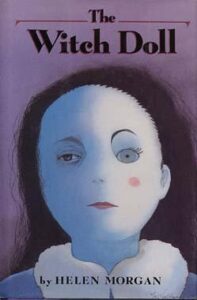
Clothilde Dupont (The Witch Doll, Helen Morgan)
Despite being marketed to children, Helen Morgan’s The Witch Doll features one of the grossest dolls in Western Literature. Clothilde is cold, snobby, and criticizes the way other people dress, which seems on brand for a French governess. Where she goes wildly off the rails is her obsession with knitting tiny wigs out of people’s hair that she fits onto her wooden doll. As she combs the wig, its hair gets longer, the doll grows larger, and the hair donor’s body shrinks until they become a doll and the doll becomes them. That taste in your mouth? That’s your gorge hitting the back of your throat.

PIN (Pin, Andrew Neiderman)
Most famous as VC Andrews’ ghostwriter (he wrote 68 novels under her name), Neiderman also wrote a number of upsetting books himself (47 of them) and this is ground zero in his squick-iverse. Leon and Ursula’s Dad (whom they refer to as “the Doctor”) conducted every awkward conversation with his children by throwing his voice into a transparent, life-sized anatomical dummy he named PIN. Now they’re grown up, the Doctor is dead, and PIN keeps talking to them, so they include him in all their activities, like family dinners, listening to Leon’s weird poetry recitals, and incest. There’s a reason Neiderman got tapped to carry the torch for Andrews, and never is it more evident than in this sick little thriller.

Julio (“The Doll”, Daphne du Maurier)
Written in 1937 and presumed lost until it was republished in 2011, this short story features du Maurier writing about another obsession-inspiring dark lady named Rebecca, although no one wanted to make a posh studio film about this disgusting weirdo. Rebecca of “The Doll” plays violin, and becomes the target of an obsessive case of the hornies by the narrator until she decides to open up to him and reveal her special secret: a room in her apartment that belongs to a large, wooden puppet named Julio. Who is her lover. Essentially a clockwork sex doll, the sight of Julio giving the object of his obsession intimate splinters drives the narrator insane, and it all happens in under 6,000 words. Give Julio doll points for efficiency, at the very least.
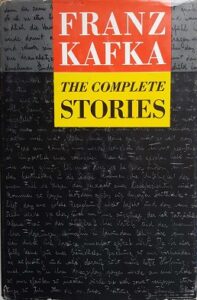
Odradek (“The Cares of a Family Man”, Franz Kafka)
Another short story, but even though no one’s having sex with Odradek he might be even more disturbing than Julio. Published in 1914, “The Cares of a Family Man” tells the tale of a father who moves his family into a new home and discovers it already has a tenant. Odradek is a crude doll made of a spool with sticks for arms and legs and it rolls around the house, giving cryptic answers to questions, not really harming anyone, just doing his own thing. Which is, let’s be honest, disturbing enough, especially because he’s not really alive, which means he can’t die. “He does no harm to anyone that one can see;” the Family Man thinks. “But the idea that he is likely to survive me I find almost painful.”
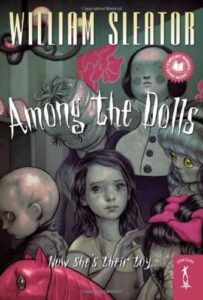
The Mother (Among the Dolls, William Sleator)
In barely 70 pages, children’s author William Sleator demonstrates why his books should be rounded up from school libraries and burned. Published in 1975, this tiny terrorizer tells the tale of Vicky, who acts out her parents’ fracturing marriage with the dolls in her dollhouse. That might be healthy roleplaying until she shrinks to their size and seeks shelter in the dollhouse herself, discovering that her dolls are not happy about being used in her therapy. “Aha,” one of them says. “You are small and helpless now, I see.” Uh-oh. The dollhouse and its dolls are grimy and poorly made, chipped and cracked and grotesque when seen up close. The dolls have been made monstrous by Vicky’s psychodramas and they’ve named themselves, but the worst of them has no name at all, she is only The Mother. “She had created them,” Sleator writes. “And now they were turned against her.”
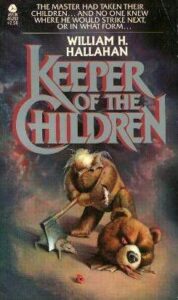
Absolutely Everything (Keeper of the Children, William H. Hallahan)
When Edward’s 14 year old daughter joins a cult that practices yoga, he thinks it’s mortifying enough to see his child panhandling downtown and doing Warrior Pose in the public park. But when he tries to kidnap and deprogram her he learns that there’s more to yoga than mindfulness and core strength, as the cult’s leader uses his yoga powers to animate objects and send them on assassination missions. There’s a superstrong scarecrow that hops up and down on people until they die, leaving “little broomstick footprints” on their corpses, a department store mannequin wielding a golf club, a relentless witch marionette, a teddy bear with an axe, and don’t even get me started on the clown doll with a baseball bat.
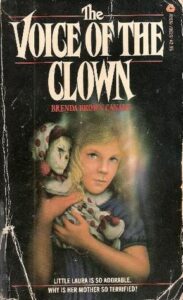
The Clown (Voice of the Clown, Brenda Brown Canary)
Speaking of clown dolls, meet Laura. She’s six years old and she has your number. She knows all the tricks that adults might try to play on her, all the ways they attempt to manipulate her into doing what they want, all the lies they tell. How? Simple, her little clown doll tells her. No one knows where her doll came from, he just appeared in her crib one day, but he makes sure no one takes advantage of little Laura, but, now that her stepmother is pregnant, the clown’s getting worried about Laura’s place in the family and he’ll do anything to secure it. As the book says, “Her clown hated her mother.” Which are the last words you ever want to hear about your child’s stuffed clown.
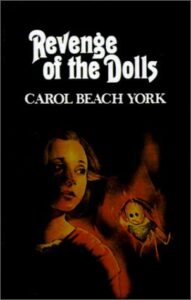
Whatever The Hell Is In That Package (Revenge of the Dolls, Carol Beach York)
Another short, sharp shock from the Seventies, once again inexplicably marketed to children, Carol Beach York’s slim novel follows Alice as her parents take her along to her grandmother’s house so the adults can decide whether it’s time for Granny to be warehoused in a nursing home so they can sell her house. Granny has a doll collection, and when cousin Paulie chucks one of the dolls into the fire out of spite, Alice is left to run interference. Grandma sees right through her, however, and makes a special doll for Paulie, one she animates with her blood, then she wraps it up, and gives the package to Alice to mail. A book marinated in all the emo dread of early adolescence and lit by the dying embers of a childhood going down in flames, this book is all about the death of innocence at the hands of a doll.
***


















